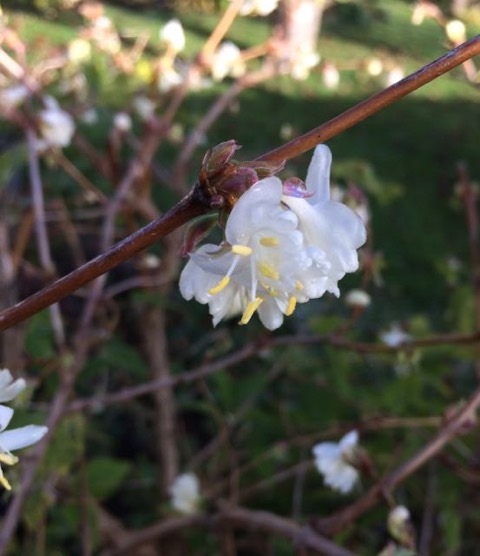
Lonicera fragrantissima
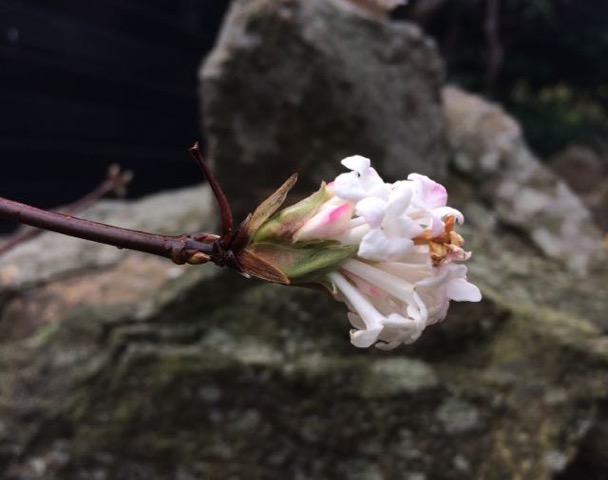
Viburnum x bodnantense ‘Dawn’
Late autumn has been a colourful time in the garden this year, and perhaps persisted for longer due to rain earlier in the season. But with high winds and now a sharp cold snap the flowers have faded and the birds have nearly finished stripping the berries. But it doesn't take long to sense the shift to winter-flowering plants and on a cold bright day to notice that it is scent not colour that dominates.
Just outside my greenhouse is Lonicera fragratissima filling the air with a light lemony scent, and by the wall in the front garden Viburnum x bodnantense 'Dawn' with sweet powdery notes.


Soon Sarcoccoca x confusa will be adding the spicier tones, but I find Sarcococca hookeriana var. digyna flowers rather later, certainly not until after Christmas. And although Iris unguicularis is said to be scented I confess I cannot detect its scent, even when picked and brought into the warmth.
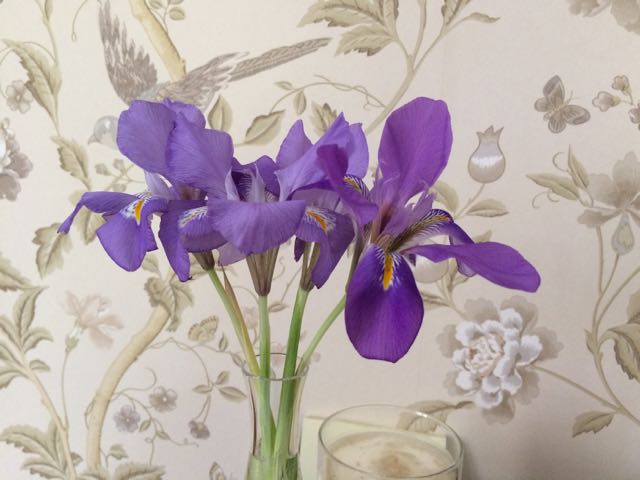
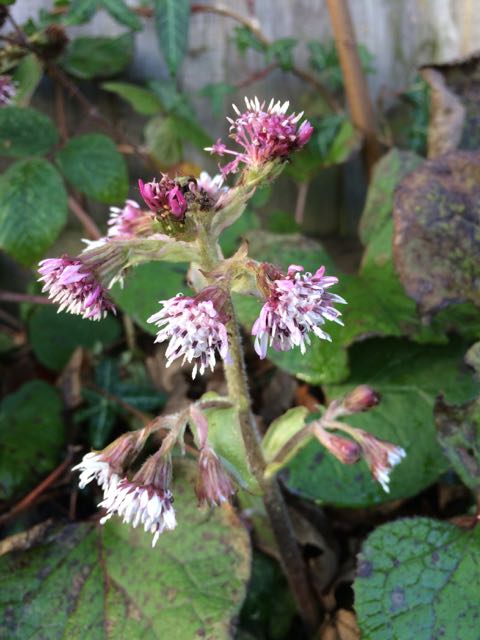
But my 'stop and sniff' plant grows out under a fence along the top of a low wall that I pass on my way to town. It is Petasites fragrans, the winter heliotrope. The sweet scent carries quite a way especially in the warmth of a patch of sunlight. It's not for my garden though as in spite of it's sweet fragrance it is a thug at heart! It was first introduced to British gardens from North Africa in 1806, but has 'escaped' and is now naturalised in many areas in southern Britain and interestingly, although dioecious, only male plants are found here and it colonises by spreading rhizomes.
But perhaps the most eagerly awaited event will be the first flowers on my Chimonanthus praecox. I planted this two years ago as a small act of defiance after my neighbour ripped out his mature tree that had given me so much pleasure over the years we have lived here because it was in the way of the new extension and was he said, "an ugly thing". The twigs are sprouting little fat round buds now, and while I keep a check on progress there are the cinnamon buds that positively gleam in the sun on Magnolia laevifolia against the same stretch of wall, whilst up above the flowers of Clematis cirrhosa look so good against the sky.
.jpg)
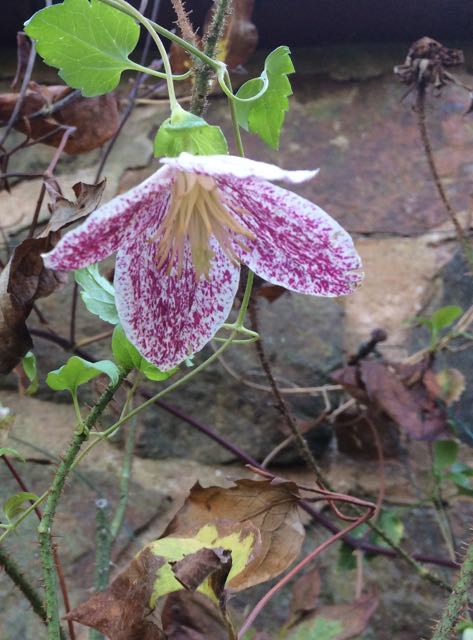
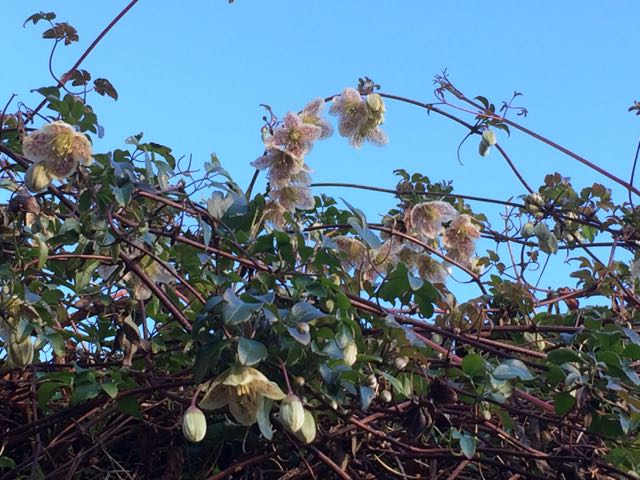
I've planted Clematis cirrhosa 'Freckles' on the wall at the end of the garden. The flowers are bigger and the 'freckling' much darker, but it is harder to get a good picture because it is on the north side of the wall where there is often too much contrast between sun and shade.
Gardeners have a tendency to complain about the weather, and we are currently experiencing the longest June hot spell over 30°C since 1976 with five consecutive days of high temperatures and very little significant rainfall for over a month. I returned from holiday in Sicily to enjoy the same hot sunshine (no need to wish for a woolly jumper on touchdown at Gatwick!) and to find that my worries about how the garden would have fared during my absence had been unnecessary. I had asked my daughter to water the plants in the greenhouse and all the pots still awaiting a final home, and not only had she done a magnificent job, but was clearly recruiting the younger generation to a love of horticulture…..



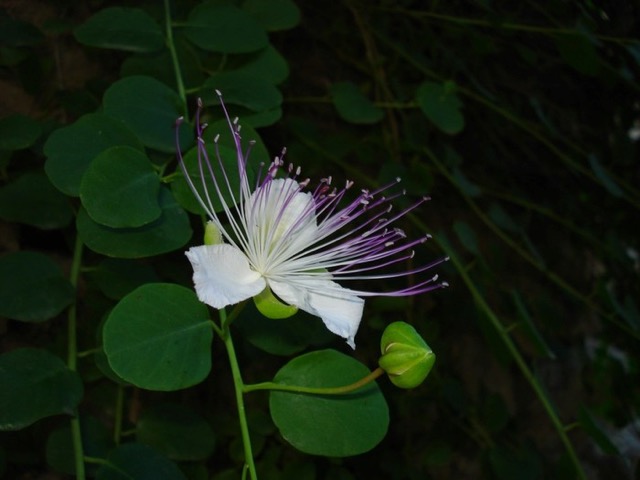
I must confess that I don’t do much botanising on holiday, but finally discovered that a plant I have often seen around the Mediterranean is the caper, Capparis spinosa L. subsp. rupestris (Sm.) Nyman. The unripe flower buds are pickled, usually in vinegar, and are a flavouring I’m particularly fond of using with pasta, fish, chicken, lamb etc. The name Nyman refers, I believe, to the Swedish botanist Carl Fredrik Nyman (1820-1893) although it seemed a remarkable coincidence that we had visited Nymans, the NT garden in Sussex, the day before we flew off. The name of the garden comes from Robert Nyuweman who owned the land during the 14th century, but became famous for its gardens developed by the Messel family in the early 20th century.
From the beginning of February a daily walk around the garden has been essential. Over the last couple of years I have been adding a few (well, quite a few) different snowdrops and it is a delight to examine them as they emerge. But, all of a sudden, in the last few days it seems the hellebores have taken over the spotlight. I find it hard to resist putting new ones in the garden every year, from the two luscious doubles that I chose on my retirement in January 2013 and planted with the snowdrops I was given as a leaving present from St Richards Hospice, to the gorgeous yellows (I remember how rare the yellow hellebore was when the HPS used it as the logo), picotees and new hybrids.
I never used to remove the foliage in late winter, but leaf spot does seem to be much more prevalent these days, disfiguring leaves with unsightly black patches, and the task of going round the plants in late December and early January also gives the opportunity to feed and apply a fresh mulch so that the flowers are seen to best advantage.
I started planting hellebores in this garden because there is a lot of shade, under the old apple trees and in the north-facing front garden where there is deep shade from the shadow of the house. They look best in the dappled light under the trees although the biggest hellebore in the garden, Helleborus pupurascens (Rodney Davey Marbled Group) ‘Anna’s Red’, is stunning in full sun especially when the flowers are back-lit. My first was an ordinary dusky pink garden hybrid that came with us from Leicestershire and one of my latest acquisitions is a large green-flowered hybrid from Ashwood’s that reminded me of the wonderful clumps of green-flowered hellebores that I saw last year on a visit to garden designer, Mary Keen’s garden growing on the path to the School House.
It won’t be the last!
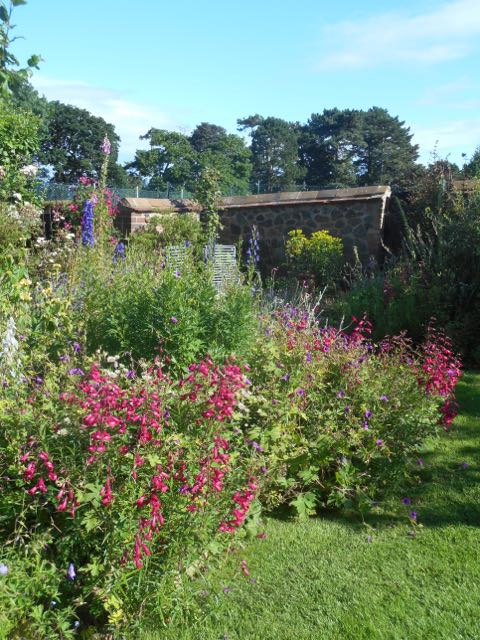
Gardening this summer seems to involve dashing out between showers to cut back perennials blown over by the wind or knocked flat by torrential rain. But I did seize the opportunity to take a couple of photographs when we returned from holiday (shivering after the heat of southern Italy) and they do prove that the sun has come out however briefly.
The penstemons are providing most of the colour with the large clump of aconite just showing it’s electric blue and the haze of purple is Geranium ‘Ann Folkard’ scrambling over everything (did I mean scrambling or strangling?!)
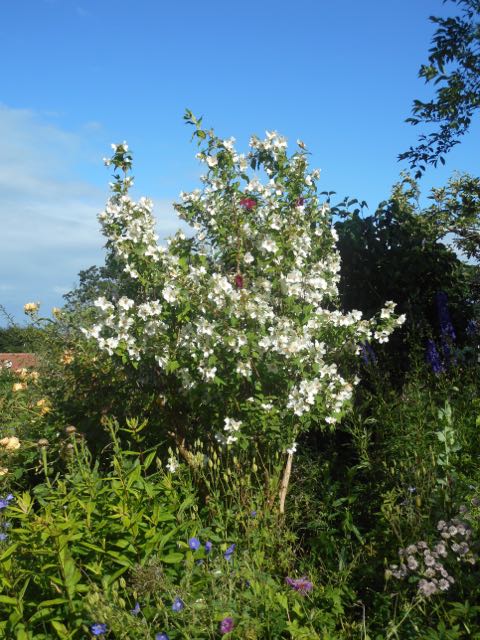
I am particularly impressed with Philadelphus ‘Belle Etoile’, absolutely smothered in flower after being pruned hard last year, and supporting Clematis ‘Madame Julia Correvon’. The clematis are doing really well this year, they are loving the wet weather.
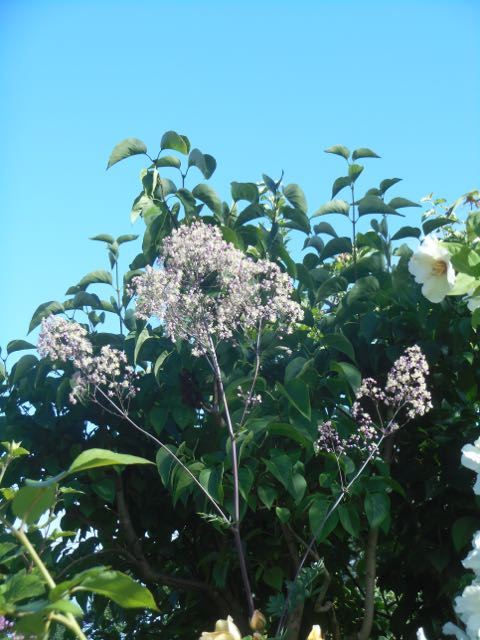
Now, can you tell the difference between Thalictrum ‘Elin’ and T. ‘Anne’. Both are tall with dark stems and dusky foliage and very architectural, but I wish the flowers remained dark rather than turning white as they mature.There is a good article on thalictrums by Val Bourne in July’s Gardens Illustrated.
No photo of the RBS I’m afraid as the weeds are obscuring the new plants! Some work required there, although it is an improvement on this time last year.
Brian and his wife Steph have been running a nursery for 20 years, both having a background in Art & Textiles - evident in the way the Library Garden resembles a tapestry of colour and texture.
They also hold National Collections of Symphyotrichum (Michaelmas daisies), Anemone nemorosa and Sanguisorba.
Brian talked us through some excellent slides of plants chosen from the Library Garden at the nursery with suggestions for combinations of plants and tips on cultivation and propagation. Many members are familiar with the garden and it had been our first stop on the way to Yorkshire on the group holiday last year in June when it looked absolutely gorgeous.
John, David, Mick, Stella and I started putting together the HPS display for the Malvern Spring Festival on a chilly Bank Holiday Monday, but by the time the show opened on Thursday the sun was shining. We were delighted to be awarded an RHS Silver medal, the first time we have chosen to be judged by the RHS (as a taster for next year when we will be at Chelsea with a display to mark the 60th Anniversary of the HPS). This year our theme was Ranunculaceae in the Garden. I will just add that the weather remained warm and sunny apart from Saturday evening when we had what can only be described as the ‘perfect storm’, thunder, lightning and a torrential downpour that turned the show ground into rivers of mud. John and Margaret heroically rescued our stand and that of Plant Heritage and kept smiling as you can see.
Yes, the sap is rising and it’s time to swing into action. I’m trying to follow the advice that I’ve heard so often, that if a plant is not living up to expectation, in the wrong place or just past it’s sell-by date then it should go. So far that has been the end of an old choisya, a rambler rose that spent its life laying thorny traps for all who dared pass, and a very vigorous shrubby honeysuckle which I think was Lonicera involucrata var. ledebourii, a Californian plant with peculiar orange-yellow tinged red flowers. I’ve also been clearing areas overrun with so-called ground cover of the thuggish variety which is opening up some lovely new areas for planting things that I’ve been sheltering overwinter having failed to plant them before the rain set in last autumn.
But, my major undertaking is going to be my ‘Bank of Shame’ or RBS as John calls it (get it?). This has to be the elephant in the garden as I have passed it often several times a day whilst it has been getting more weed-infested and overgrown for many years. It is in fact the bank that runs the length of our drive past the front door.
It has always been a problem with poor soil and erosion combined with weeds and a tangle of ivy. With winds coming from the south-west it acts like a wind tunnel and the top end is where we dump garden refuse sacks.
In the early days I planted several cistus bushes which survived a number of years until they became old and woody as they do, since when I have done my best to ignore this horror.
We decided to clear the existing vegetation starting with the end closest to the road, an area 8m long by about 1.5m wide with the height being just under 1m - which is the shallowest part so potentially easier to replant, and the most visible part from our sitting room and bedroom windows.
A couple of hours later and the enormous hebe had gone as had the euonymus which had layered itself down several times.
What you can’t see is that the roots remain and will need digging out before I can think about planting and we will have to try and create planting pockets to raise the soil level up to the grass at the top of the bank.
The big question will be what to plant? It will have to be done on a shoestring although I think small plants are likely to be able to establish themselves better. I would welcome any advice and will be raiding the monthly plant sale for anything suitable.
Why not share your plans or problem areas by sending words and pictures to me, or to
What do you do with all the back issues of gardening magazines? I always intend to cull them, but then isn’t there always a chance that I may want to look back at an article?
I was re-reading some back issues to try and reduce the pile somewhat when a couple of articles caught my eye. Both concerned the decision about when to cut back and tidy the garden, autumn or spring. The ‘glossies’ are often full of winter stems and seed heads rimed in hoar frost on a bright winter morning, but the reality of this year and last has been wet and windy weather leaving the garden a bedraggled muddy mess. There is the ecological argument that the dead stems provide homes for insects and bugs to overwinter and the seed heads to provide food for the birds, but with no real frosts it seems to be the voracious molluscs that are benefitting from the cover provided by dead perennials and the tits and finches seem perfectly happy grazing the crevices and moss on the limbs of my old apple trees after any seed heads have been laid flat in the mud by gale force winds. So for the moment my intention is to move towards an autumn tidy up.
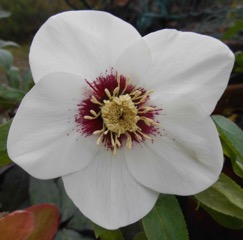
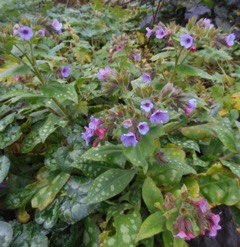
Hammamelis mollis has been flowering beautifully regardless of the weather with the snowdrops and (rather earlier than usual) the snowflakes brightening the gloom. The hellebores are looking rather battered though and the picture is of a new one that I have sheltering in the greenhouse at the moment. This pulmonaria is one of the earliest to start flowering in my garden; I’m not sure that I ever had a name for it but I remember buying it on a very early HPS visit to Abbey Dore Garden. It is larger than P. officinalis and the leaves have a rather soft, misty appearance with soft blue/pink flowers. It has remained true over many years and I would be interested if anyone has a similar plant or could tell me its name.
Finally, I am pleased that the Worcestershire Group now has a Facebook page. Please take a look and add your comments.
Happy New Year everyone!
Take heart, we’ve passed the shortest day of the old year and are now getting into the swing of 2016. In spite of the persistent rain, temperatures have stayed well above freezing and there signs that spring is well on its way in the garden, only making it more frustrating that it is practically impossible to do more than splodge around in wellies. I haven’t even felt motivated to take my new camera lens out for a trial run although a brief glimpse of the sun sent me out to take a few snaps and I went round on New Years Day to do a flower count. I felt a bit of a cheat as so many of the blooms were rain damaged, but included them anyway. I found that my total was well up on last year, but fewer late season hangers on and more early risers, the exception being Salvia ‘Amistad’ which has been quite magnificent for months. The most photogenic rising star is once again Helleborus ‘Anna’s Red’.
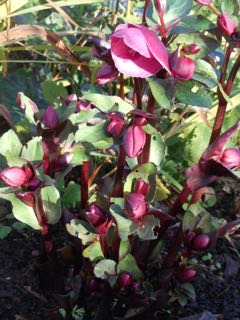
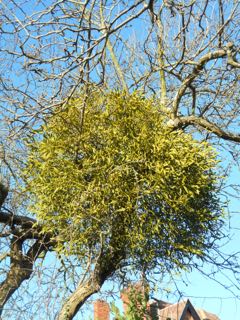
I covet this lovely mistletoe growing in my neighbour’s cherry tree. Although I have a garden full of old apple trees I have never managed to seed them with mistletoe and this is a male clump so no hope of the birds bringing berries to ‘process’ on my branches.
A brief bout of ‘galanthophilia’ last spring is bringing exciting results as one by one my new acquisitions are pushing their green tips above the sodden soil. First up was Galanthus ‘Dionysus’, one of the Greatorex* doubles, followed by G. nivalis and G. elwesii ‘Elmley Lovett’.
Please contribute to the ‘Spotlight’ by sending your comments and photos to me at
* Heyrick Greatorex (d. 1954) was a commissioned cavalry officer in the Great War and captain of a Home Guard detachment in the Second World War. He latterly became very reclusive, leading a new age lifestyle in a converted railway carriage at the bottom of his garden in Brundall, Norfolk. In the 1940's he used pollen from nivalis flore pleno and crossed it with Galanthus plicatus to produce a range of hybrid doubles. The resulting plants (mostly named after female Shakespearean characters) were tall, vigorous and robust and with their large, regular and neat flowers caused something of a sensation.
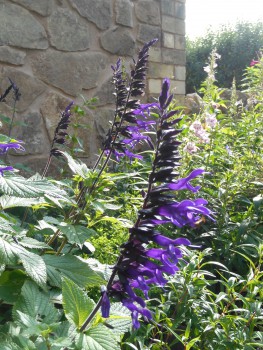
A wet start to November although mild; I’m undecided about whether to insulate my greenhouse because if winter is not that cold it causes problems with poor ventilation. I expect I shall just drape some horticultural fleece over if frosts are predicted. I still haven’t brought the summer pots in or finished planting bulbs yet - there’s never sufficient time. I had a chuckle watching the last Gardener’s World of the series when MD suggested scattering bulbs on the ground and covering them with leaf mould, as the squirrels would be delighted with such easy pickings!
The garden is looking very bedraggled with little colour remaining now, although the mahonia is in bud and the winter jasmine has started to flower by the front gate. I’ve had to cut Clematis armandii hard back because the builders needed access to re-roof the breakfast room so I may not get flowers this spring, but Clematis cirrhosis has staged a comeback (you will remember that this was one of the casualties of my ‘party wall episode’!) and has scaled the wall once more so I do hope it flowers. The border here has been more difficult to re-establish. I concentrated on shrubs and climbers first, infilling with penstemon cuttings and a few other bits and bobs and
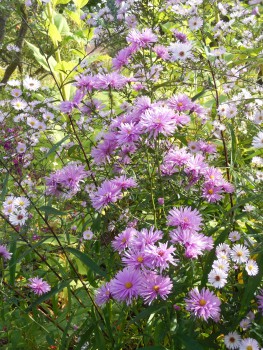
Symphycotrichum novae-belgii
'Farncombe Lilac'
these will need sorting out next year. A real star though has been Salvia ‘Amistad’, a very kind gift from Jackie at the end of last year along with another super salvia, S. ‘African Skies’
Elsewhere the asters seemed to have a good season, especially the conservation plant Symphycotrichum novae-belgii ‘Farncombe Lilac’.
I realise that I didn’t take any pictures in my garden in October - I wonder why? Perhaps I just couldn’t compete with the gardens I visited last month: The Picton Garden, Waterperry and The Garden House. This was my first visit to The Garden House and I was absolutely captivated with the situation and planting. The Walled Garden and the Acer Rill were spectacular and I am determined to make a return visit before too long.
Why not contribute to this blog by sending me a few words (and pictures of course) about what has done well in your garden this year.
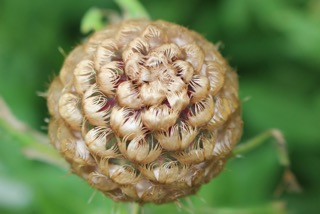
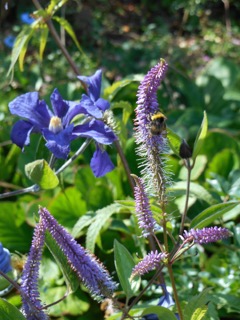
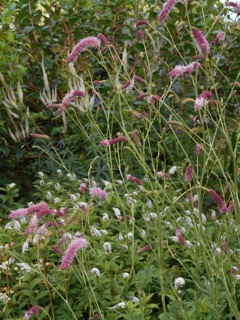
What a summer! A very long dry spell, although sunshine was in fairly short supply, then torrential storms. How have your gardens fared? I am trying to get round the garden dead-heading and continuing to try to find spots to plant new acquisitions. I still have plants in pots that should have been in ages ago, but for so long the ground was parched and cracked. I do hope we have a long warm autumn to compensate although the nights are drawing in very fast.
I try to remember to take my camera around the garden every few days. I find shots across the garden difficult as I rarely seem to have a group of plants all performing together, but these are some of my favourite plant portraits: a beautiful bud of Centaurea macrocephala (so much more attractive than the flower), a bee on Veronicastrum ‘Fascination’ with Clematis x durandii behind and Sanguisorba ‘Pink Tails’ (from Stockton Bury) with Lysimachia clethroides and Veronicastrum virginicum ‘Album’.
I do hope that you are looking forward to our 20th anniversary celebration as much as I am. I’ve particularly enjoyed compiling a special commemorative newsletter, especially the chance to read through 20 years worth of Worcestershire group newsletters - I have Jackie Davies to thank for keeping a complete set.
The HPS display this year was ‘Perennials for Shade and Woodland’ to promote the formation of this latest special interest group. We also had the publication of the new Hardy Geranium booklet, completely revised and updated by Margaret Stone and an educational display about the Seed Distribution.
The days leading up to the show on Thusday 7th May were extremely wet and windy. This year we were in a marquee rather than the cattle sheds and at times over the Tuesday and Wednesday it felt as though the tent might take flight! John and David were as efficient as always in constructing the display setting, ensuring that there was a back room for storage and a kettle. I had the privilege of going with John to select plants from Cotswold Garden Flowers and it was very exciting as we unloaded the crates on Tuesday morning. Stella’s dressmaking skills were invaluable as she helped cover the tables with black fabric and the photo displays looked stunning against the black backdrop. Finally we stuffed newspaper between the plant pots and covered the surface with bark, finishing at teatime on Wednesday.
Thursday morning saw us return and await the judges decision; and so exciting to be awarded a ‘GOLD’ by the 3 Counties Agricultural Society. Many people visited the stand over the 4 days of the Show, both HPS members and the public, all interested by the plants which did look amazing as you can see from the photographs. The border at the back showed planting suitable for the shade of a house or garden wall (thanks for the wall photo, Colin) and the front border included plants suitable for woodland or shade from trees in the garden.
Finally it was time to pack everything away again and what team work as we finished in a record 2 hours, leaving John to return in the morning with the van to collect the plants and building materials.
A week of warm sunshine after an early and rather cold Easter has meant that every day new shoots are emerging and 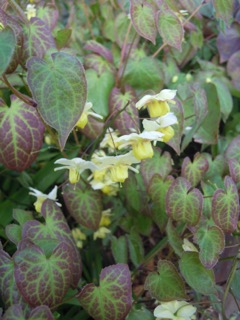 plants are advancing at a tremendous rate. It is a time of year when on the one hand you wish everything would slow down, preserving that new green freshness, and on the other hand eagerly anticipating new plants coming into flower. In fact it is very difficult to pick pictures which perfectly capture the moment. I have picked an epimedium because I love the colouring of the new leaves - this is Epimedium x versicolor ‘Sulphureum’ AGM which I have had for many years.
plants are advancing at a tremendous rate. It is a time of year when on the one hand you wish everything would slow down, preserving that new green freshness, and on the other hand eagerly anticipating new plants coming into flower. In fact it is very difficult to pick pictures which perfectly capture the moment. I have picked an epimedium because I love the colouring of the new leaves - this is Epimedium x versicolor ‘Sulphureum’ AGM which I have had for many years.
Sally Gregson of Mill Cottage Plants came to my local garden club to talk about epimediums and introduced us to some of the many new varieties from China and Japan. Needless to say one or two found their way home with me and I have planted them in shady spots with a good helping of leaf mould.
Those of you who were at our April meeting will know that I am hoping to start a Plant Wants list and try to find someone in the group who grows the requested plant. We will have a list at meetings, but I hope we shall be able to put it on the website as well.
There really is nothing like backlighting to enhance a photo. Each year I try and capture the perfect shot of Lamprocapnos spectabilis…
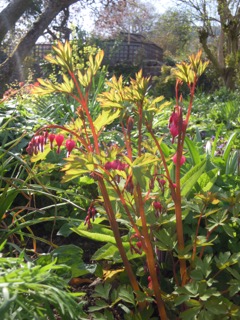
Please send your favourite pictures to and share them with the group.
 I am really looking forward to our afternoon with Anna Pavord next Saturday. I have read many of her articles and particularly enjoyed ‘The Naming of Names’, a very readable history of how people started to group the plants they knew, firstly according to how they were used and later by their appearance, before Linnaeus introduced the system of classification using binomial nomenclature and based on shared physical characteristics.
I am really looking forward to our afternoon with Anna Pavord next Saturday. I have read many of her articles and particularly enjoyed ‘The Naming of Names’, a very readable history of how people started to group the plants they knew, firstly according to how they were used and later by their appearance, before Linnaeus introduced the system of classification using binomial nomenclature and based on shared physical characteristics.
This rather lovely hellebore is also called Anna, well Helleborus (Rodney Davey Marbled Group) ‘Anna’s Red’ to be precise. I knew it had been named after Anna Pavord, but I wanted to find out more. Then I discovered that Anna herself had written about it in her column in The Independent in February 2012. She explained that she regularly visited Rodney Davey and Lynda Windsor who have a nursery in Tytherleigh, Devon. Rodney breeds hellebores and had been working for years to grow a red-flowered hellebore with marbled leaves. He finally achieved his aim and then, via John Massey of Ashwood Nursery, the plant was taken to Holland and micro-propagated so that  we can all enjoy it’s extraordinary beauty. It is a strong grower, the stems dark, the leaves are marbled (pink on young leaves turning to cream veining as they age) and it has large, deep crimson flowers with creamy-yellow stamens.
we can all enjoy it’s extraordinary beauty. It is a strong grower, the stems dark, the leaves are marbled (pink on young leaves turning to cream veining as they age) and it has large, deep crimson flowers with creamy-yellow stamens.
Just to update the situation regarding my wall, there is now a large breach and a very deep hole! Difficult to photograph because of the angle, but you can see that the path has been closed off so that I don’t fall in.
I would welcome any contributions to the ‘Spotlight’. Please send your jottings and photos to me at
Sadly it is time to lose another of my favourite winter plants. I’m already missing the amazing fragrance and exquisite flowers of Chimonanthus praecox which grew as a small tree in my neighbour’s garden which was unceremoniously grubbed out last autumn, and 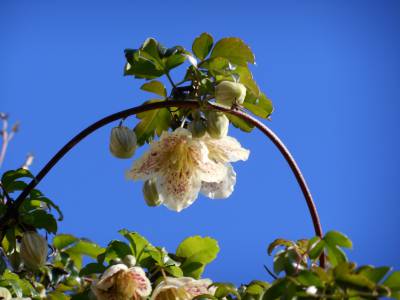 now it is the turn of my Clematis cirrhosa var. balearica which must be cut back whilst in full flower. Like most winter flowers it is a magnet for insects on a sunny day, providing much needed sustenance. The clematis scrambles through Hydrangea petiolaris which must also be cut back to half its height so that the wall can be strengthened to take the neighbour’s extension. I hope both climbers will survive and regrow. Meanwhile I must finish clearing the border for some distance beyond their roots and try to bag up some of the topsoil before the builders excavate to convert a garden wall into a higher supporting wall for the extension. I am hoping that work will be completed to allow me to replant during the spring as this area is in full view of my kitchen window and forms one side of the terrace.
now it is the turn of my Clematis cirrhosa var. balearica which must be cut back whilst in full flower. Like most winter flowers it is a magnet for insects on a sunny day, providing much needed sustenance. The clematis scrambles through Hydrangea petiolaris which must also be cut back to half its height so that the wall can be strengthened to take the neighbour’s extension. I hope both climbers will survive and regrow. Meanwhile I must finish clearing the border for some distance beyond their roots and try to bag up some of the topsoil before the builders excavate to convert a garden wall into a higher supporting wall for the extension. I am hoping that work will be completed to allow me to replant during the spring as this area is in full view of my kitchen window and forms one side of the terrace.
I have grown Clematis cirrhosa var. balearica for some years on this west-facing wall outside my back door. The foliage is deeply cut and evergreen, developing bronze tints in winter. The flowers hang down in clusters of 4-petalled bells, creamy white with a scattering of reddish-brown speckles and scented with a light citrus fragrance. This clematis was originally introduced to England from the Balearic Islands off the southern coast of Spain in 1783.
Meanwhile, we are experiencing the first real frosts in a couple of years, although temperatures have only just dipped below freezing with a light sprinkle of snow on the Malvern Hills. But for now the rain has eased and in these bright frosty days the snowdrops shine like jewels. I would love to know why I can’t establish the winter aconite in my garden. After all I am plagued by its close relatives, celandines and buttercups, but I suspect it is less tolerant of drying out in summer.
These days autumn planting seems focussed towards the larger perennials and grasses often
planted in a more naturalistic style than the traditional border. But as I sat looking out at my garden
in the afternoon sunshine my eye was caught by Zauschneria californica. I originally planted it on
the steep bank at the side of my drive at least 15 years ago, since when it has gradually climbed to
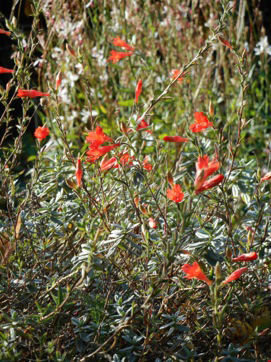 the top and into a bed with cistus and helianthemums.
the top and into a bed with cistus and helianthemums.
Zauschneria was introduced from the west coast of North America, hence its common name of Californian fuchsia. In its native habitat Z. californica is pollinated by hummingbirds and the flowers are adapted to this purpose. Each bloom is long and tubular with the vermilion coloured petals opening into a dissected trumpet. The flower spikes do not open all at once and so although not a mass of colour it does light up the border for many weeks, particularly when a low sun shines through the flowers, backlighting them.
Z. californica forms a low clump of hairy, narrow, greyish-green leaves of less than an inch in length. It spreads gently by rhizomes, although some of its cultivars are more vigorous. It thrives in nutrient-deficient, sun-baked soil, to which it has adapted by evolving water and starch-storing rhizomatous roots and tiny silvery leaves that reduce transpiration. The bases of its stems are quite woody, indicating that it belongs to the loosely defined group known as xerophytes or xerophytic sub-shrubs - a group that includes santolina and lavender. These adaptations make it the perfect plant for rock and gravel gardens, raised beds or dry-stone walls.